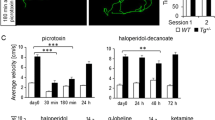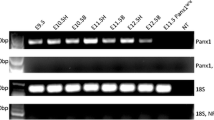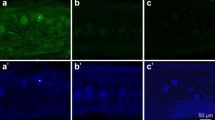Abstract
Immunohistochemistry for neuron-specific nuclear protein (NeuN), caspase-3, calcitonin gene-related peptide (CGRP), and calcium-binding proteins was performed on the trigeminal ganglion (TG) in wild type and Brn-3a knockout mice at embryonic days 12.5–16.5 (E12.5–E16.5). In Brn-3a knockout mice, the number of NeuN-immunoreactive (ir) neuron profiles increased at E14.5 (40.0% increase) and decreased at E16.5 (28.3% reduction) compared to wild type mice. Caspase-3-ir neuron profiles were abundant in the TG of wild type mice at E12.5–E16.5. However, the loss of Brn-3a decreased the number of caspase-3-ir neuron profiles at E12.5 (69.7% reduction) and E14.5 (51.7% reduction). At E16.5, the distribution of caspase-3-ir neuron profiles was barely affected by the deficiency. CGRP-ir neuron profiles were observed in the TG of wild type mice but not knockout mice at E12.5. At E14.5 and E16.5, CGRP-ir neuron profiles were abundant in both wild type and knockout mice. Calbindin D-28 k (CB)-ir neuron profiles decreased in the TG of mutant mice at E12.5 compared to wild type mice (56.4% reduction). At E14.5, however, Brn-3a deficiency transiently increased CB-ir neuron profiles (169.4% increase as compared to wild type mice). Calretinin (CR)-ir neuron profiles could not be detected in the TG of wild type mice at E12.5–16.5. However, numerous CR-ir neuron profiles transiently appeared in the knockout mouse at E14.5. Parvalbumin (PV)-ir neurons appeared in wild type and knockout mice at E14.5. At this stage, the number of large (>50 μm2) PV-ir neuron profiles in knockout mice was fewer than that in wild type mice. The number and cell size of PV-ir neuron profiles were barely affected by the deficiency at E16.5. The present study indicates that the loss of Brn-3a causes increase of TG neurons at E14.5 and decrease of TG neurons at E16.5. It is also suggested that Brn-3a deficiency affects the number and cell size of CGRP- and calcium-binding protein-containing neurons at E12.5 and E14.5. Caspase-3-dependent cell death of CB- and CR-ir neurons may be suppressed by the deficiency at E14.5.






Similar content being viewed by others
References
Eng SR, Gratwick K, Rhee JM, Fedtsova N, Gan L, Turner EE (2001) Defects in sensory axon growth precede neuronal death in Brn3a-deficient mice. J Neurosci 21:541–549
Eng SR, Lanier J, Fedtsova N, Turner EE (2004) Coordinated regulation of gene expression by Brn3a in developing sensory ganglia. Development 131:3859–3870. doi:10.1242/dev.01260
Ensor E, Smith MD, Latchman DS (2001) The Brn-3a transcription factor protects sensory but not sympathetic neurons from programmed cell death/apoptosis. J Biol Chem 276:5204–5212. doi:10.1074/jbc.M007068200
Huang EJ, Zang K, Schmidt A, Saulys A, Xiang M, Reichardt LF (1999) POU domain factor Brn-3a controls the differentiation and survival of trigeminal neurons by regulating Trk receptor expression. Development 126:2869–2882
Ichikawa H, Wakisaka S, Matsuo S, Akai M (1989) Peptidergic innervation of the temporomandibular disk in the rat. Experientia 45:303–304. doi:10.1007/BF01951817
Ichikawa H, Yamaai T, Jacobowitz DM, Mo Z, Xiang M, Sugimoto T (2002) Effect of Brn-3a deficiency on parvalbumin-, calbindin D-28 k-, calretinin- and calcitonin gene-related peptide-immunoreactive primary sensory neurons in the trigeminal ganglion. Neuroscience 113:537–546. doi:10.1016/S0306-4522(02)00182-3
Latchman DS (1998) The Brn-3a transcription factor. Int J Biochem Cell Biol 30:1153–1157. doi:10.1016/S1357-2725(98)00090-9
McEvilly RJ, Erkman L, Luo L, Sawchenko PE, Ryan AF, Rosenfeld MG (1996) Requirement for Brn-3.0 in differentiation and survival of sensory and motor neurons. Nature 384:574–577. doi:10.1038/384574a0
Smith MD, Dawson SJ, Latchman DS (1997a) The Brn-3a transcription factor induces neuronal process outgrowth and the coordinate expression of genes encoding synaptic proteins. Mol Cell Biol 17:345–354
Smith MD, Morris PJ, Dawson SJ, Schwartz ML, Schlaepfer WW, Latchman DS (1997b) Coordinate induction of the three neurofilament genes by the Brn-3a transcription factor. J Biol Chem 272:21325–21333. doi:10.1074/jbc.272.34.21325
Smith MD, Ensor EA, Coffin RS, Boxer LM, Latchman DS (1998) Bcl-2 transcription from the proximal P2 promoter is activated in neuronal cells by the Brn-3a POU family transcription factor. J Biol Chem 273:16715–16722. doi:10.1074/jbc.273.27.16715
Sugimoto T, Jin H, Fujita M, Fukunaga T, Nagaoka N, Yamaai T, Ichikawa H (2004) Induction of activated caspase-3-immunoreactivity and apoptosis in the trigeminal ganglion neurons by neonatal peripheral nerve injury. Brain Res 1017:238–243. doi:10.1016/j.brainres.2004.05.069
Winsky L, Nakata H, Martin BM, Jacobowitz DM (1989) Isolation, partial amino acid sequence, and immunohistochemical localization of a brain-specific calcium-binding protein. Proc Natl Acad Sci USA 86:10139–10143. doi:10.1073/pnas.86.24.10139
Xiang M, Zhou L, Macke JP, Yoshioka T, Hendry SH, Eddy RL, Shows TB, Nathans J (1995) The Brn-3 family of POU-domain factors: primary structure, binding specificity, and expression in subsets of retinal ganglion cells and somatosensory neurons. J Neurosci 15:4762–4785
Xiang M, Gan L, Zhou L, Klein WH, Nathans J (1996) Targeted deletion of the mouse POU domain gene Brn-3a causes selective loss of neurons in the brainstem and trigeminal ganglion, uncoordinated limb movement, and impaired suckling. Proc Natl Acad Sci USA 93:11950–11955. doi:10.1073/pnas.93.21.11950
Author information
Authors and Affiliations
Corresponding author
Rights and permissions
About this article
Cite this article
Ichikawa, H., Terayama, R., Yamaai, T. et al. Brn-3a Deficiency Transiently Increases Expression of Calbindin D-28 k and Calretinin in the Trigeminal Ganglion During Embryonic Development. Cell Mol Neurobiol 29, 691–698 (2009). https://doi.org/10.1007/s10571-009-9383-5
Received:
Accepted:
Published:
Issue Date:
DOI: https://doi.org/10.1007/s10571-009-9383-5




